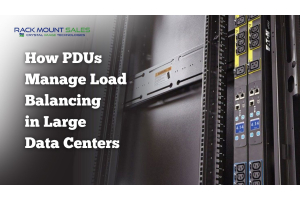The Power of Rackmount Monitors - Enhancing Efficiency and Performance in Data Centers
In the world of data centers, where space utilization, streamlined operations, and optimal performance are critical, rackmount monitors have emerged as a game-changing solution. These specialized monitors are designed to fit seamlessly into standard 19-inch racks commonly found in data centers, offering many benefits that enhance efficiency, productivity, and reliability.
In this article, we will explore the importance of rackmount monitors and their impact on data center operations. We will delve into their space-saving design, which maximizes floor space and improves airflow for better equipment performance. Additionally, we will discuss how rackmount monitors provide enhanced visibility and monitoring capabilities, enabling data center managers to easily monitor multiple devices and systems from a centralized display.
By the end of this article, you will have a comprehensive understanding of the benefits and functionalities of rackmount monitors and how they can optimize data center operations, whether in small-scale facilities or large enterprise environments.
The Importance of Space-Saving Design
Efficient space utilization is critical in data centers, where every square inch counts. Traditional monitors take up valuable desk or floor space, which can be better utilized for other equipment or infrastructure. Rackmount monitors, on the other hand, are specifically designed to fit into standard 19-inch racks commonly used in data centers.
By mounting the monitors directly into the racks, data center managers can reclaim precious floor space. This not only improves the overall organization and accessibility within the data center but also allows for better airflow and ventilation, which is crucial for maintaining optimal operating temperatures and reducing the risk of equipment failure.
Enhanced Visibility and Monitoring
Monitoring the status and performance of data center systems is a constant task for managers and technicians. Rackmount monitors provide a convenient and centralized solution for displaying vital information in real-time. Data center managers can easily monitor multiple servers, switches, and other devices through a single monitor, reducing the need for multiple displays and improving operational efficiency.
The versatility of rackmount monitors allows them to display a wide range of information, such as system health, network activity, power usage, and environmental conditions. This comprehensive view enables data center personnel to quickly identify and address any issues or anomalies, minimizing downtime and ensuring the smooth operation of critical systems.
Seamless Remote Access and Management
Data center operations often require remote access and management capabilities. Rackmount monitors facilitate remote monitoring and control by providing easy access to critical information from any location. Through secure network connections, data center managers can remotely view the rackmount monitor's display and take necessary actions without physically being present in the data center.
This remote accessibility is particularly valuable for data centers with geographically dispersed locations or when immediate response is needed outside regular working hours. It enables efficient troubleshooting, system maintenance, and proactive monitoring, reducing the time and costs associated with on-site visits.
With rackmount monitors, data center managers can remotely monitor and manage their data center infrastructure with ease. They can access the display of the rackmount monitor from their office, home, or any other location with an internet connection. This level of remote access empowers them to quickly respond to alerts, diagnose issues, and make necessary adjustments or repairs in real time.
For example, if a critical system in the data center experiences a performance slowdown or an alarm is triggered, the data center manager can remotely access the rackmount monitor's display and analyze the situation. They can view system metrics, error logs, and performance data to identify the root cause of the issue. This ability to remotely troubleshoot and diagnose problems significantly reduces response times, minimizing the impact on operations and preventing potential downtime.
In addition to troubleshooting, rackmount monitors enable efficient system maintenance. Data center managers can remotely perform routine tasks such as firmware updates, configuration changes, and software installations without physically being present in the data center. This not only saves time but also reduces the disruption to ongoing operations.
Durability and Reliability in Challenging Environments
Data centers are dynamic environments with high levels of heat, dust, and vibration. Standard monitors may not be able to withstand such conditions, leading to premature failure and potential data loss. Rackmount monitors, however, are specifically engineered to meet the demanding requirements of data centers.
These monitors are built with rugged components and robust construction to withstand extreme temperatures, dust accumulation, and mechanical vibrations. This durability ensures uninterrupted operation, reducing the risk of monitor failures and the subsequent impact on data center operations.
Furthermore, rackmount monitors often come with additional features such as anti-glare screens, protective coatings, and adjustable mounting options to accommodate various data center setups. These features enhance the user experience and contribute to the overall reliability of the monitoring solution.
Efficient Cable Management
Streamlined Cable Organization Data centers are notorious for their complex cable infrastructure. With numerous servers, switches, and other devices interconnected, cable management becomes crucial for maintaining order and minimizing the risk of cable-related issues. Rackmount monitors contribute to efficient cable management by offering integrated cable routing and management features. These monitors often have built-in cable channels or hooks that allow data center managers to route and secure cables neatly. This not only reduces cable clutter but also improves airflow and facilitates easier access for maintenance or equipment upgrades. With well-organized cables, data center personnel can quickly identify and troubleshoot connectivity problems, leading to faster resolution and minimized downtime.
Enhanced Ergonomics Heading: User-Friendly Design for Operators Data center operators spend significant time monitoring and managing systems within the data center. Therefore, their comfort and well-being are essential factors to consider. Rackmount monitors are designed with user-friendly features to promote ergonomic comfort during long working hours. These monitors often offer adjustable viewing angles and heights, allowing operators to position the display at a comfortable eye level. Ergonomic designs reduce strain on the neck and back, minimizing the risk of discomfort or injury. By prioritizing the well-being of operators, rackmount monitors contribute to a more productive and sustainable work environment.
Flexibility and Scalability:
Accommodating Changing Data Center Needs Data centers are dynamic environments that evolve, requiring the ability to adapt to changing needs and technologies. Rackmount monitors offer flexibility and scalability to meet these evolving requirements. As data centers expand or reconfigure their infrastructure, rackmount monitors can easily be added or relocated within the racks to accommodate the changes. This scalability extends to connectivity options as well. Rackmount monitors often provide a range of video input options, including VGA, DVI, HDMI, and DisplayPort. This versatility allows data center managers to connect the monitors to different devices and systems, ensuring compatibility with evolving technologies.
Energy Efficiency:
Reduced Power Consumption Energy efficiency is a key concern for data centers, as they consume significant amounts of power. Rackmount monitors contribute to energy efficiency by implementing power-saving features. These monitors often come with built-in sensors that automatically adjust the brightness of the display based on ambient lighting conditions. By dynamically adjusting the brightness, rackmount monitors reduce power consumption without compromising visibility. Additionally, some models feature power management settings that enable automatic sleep or power-off modes when not in use, further conserving energy. These energy-saving features help data centers reduce their carbon footprint and lower operational costs.
Conclusion
In today's data-driven world, data centers play a vital role in supporting businesses' operations. Maximizing efficiency, productivity, and reliability in these complex environments is paramount. Rackmount monitors offer a compelling solution by providing space-saving design, enhanced visibility, seamless remote access, and durability to withstand the challenging conditions of data centers.
By incorporating rackmount monitors into their infrastructure, data center managers can optimize space utilization, streamline monitoring processes, and ensure uninterrupted operations. Whether it's a small-scale data center or a large enterprise facility, the benefits of rackmount monitors make them an invaluable tool for improving the efficiency and productivity of data centers. Choose rackmount monitors from reputable providers like RackmountSales.com to harness their full potential and elevate your data center operations to new heights.











